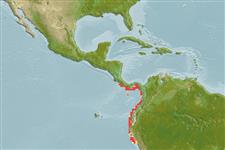Common names from other countries
Teleostei (teleosts) >
Gadiformes (Cods) >
Macrouridae (Grenadiers or rattails)
Etymology: Coelorinchus: Greek, koilos = a hollow + Greek, rhyngchos = jaw (Ref. 45335).
More on author: Garman.
Environment: milieu / climate zone / depth range / distribution range
Ecology
Marine; benthopelagic; non-migratory; depth range 120 - 460 m (Ref. 9315). Tropical; 9°N - 9°S, 86°W - 77°W (Ref. 1371)
Eastern Pacific: Costa Rica to northern Peru.
Size / Weight / Age
Maturity: Lm ? range ? - ? cm
Max length : 27.5 cm TL male/unsexed; (Ref. 42942)
Dorsal spines (total): 0; Anal spines: 0. Head large; eyes large; snout moderately pointed, its anterolateral margin incompletely supported by bone. Head ridges rather weakly scaled, other head scales mostly without spinules; the dorsal and ventral snout surfaces mostly naked. Spines on lower jaw and pectoral girdle without spinules. Light organ large, lens-shaped black fossa between the pelvic fin bases. Swim bladder oval, with 6 to 11 short retia mirabilia and gas glands. Pyloric caeca 10 to 14. Overall color is light brown to swarthy, somewhat silvery ventrally, with heavy punctuations; mouth pale, blackish along tongue base; gill cavity blackish, paler with punctuations toward inner surfaces.
Juveniles are bathypelagic (Ref. 9315). Feeds mainly on copepods and other small crustaceans, but not exclusively bottom-dwelling invertebrates (Ref. 9315).
Life cycle and mating behavior
Maturities | Reproduction | Spawnings | Egg(s) | Fecundities | Larvae
Cohen, D.M., T. Inada, T. Iwamoto and N. Scialabba, 1990. FAO species catalogue. Vol. 10. Gadiform fishes of the world (Order Gadiformes). An annotated and illustrated catalogue of cods, hakes, grenadiers and other gadiform fishes known to date. FAO Fish. Synop. 125(10). Rome: FAO. 442 p. (Ref. 1371)
IUCN Red List Status (Ref. 130435)
CITES (Ref. 128078)
Not Evaluated
Threat to humans
Harmless
Human uses
Fisheries: of no interest
Tools
Special reports
Download XML
Internet sources
Estimates based on models
Preferred temperature (Ref.
115969): 13.1 - 14.7, mean 13.8 (based on 8 cells).
Phylogenetic diversity index (Ref.
82804): PD
50 = 0.5000 [Uniqueness, from 0.5 = low to 2.0 = high].
Bayesian length-weight: a=0.00251 (0.00128 - 0.00492), b=3.19 (3.03 - 3.35), in cm Total Length, based on LWR estimates for this Genus-body shape (Ref.
93245).
Trophic level (Ref.
69278): 3.2 ±0.33 se; based on food items.
Resilience (Ref.
120179): Medium, minimum population doubling time 1.4 - 4.4 years (Preliminary K or Fecundity.).
Fishing Vulnerability (Ref.
59153): Low vulnerability (18 of 100).
